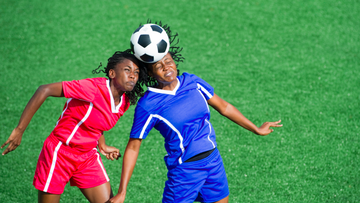Where ACL Injuries Happen Most in Women’s Soccer
Some of the biggest names were absent or sidelined from the FIFA 2023 Women’s World Cup for the same reason—ACL injuries. The Netherlands’ Vivianne Miedema, Canada’s Janine Beckie and American playerCatarina Macario all sat out of the World Cup because of ACL tears.
It’s an injury that plagues women’s soccer—much more so than men’s soccer—yet not nearly enough is done to help women understand and protect themselves from it. Yet experts understand it well enough to know what positions and manoeuvers trigger it.
The positions and manoeuvers that increase ACL tear risk
Defensive movements tend to cause the most ACL troubles. In fact, it’s been suggested that 75% of ACL tears occur when players execute defensive actions. This makes sense when you stop and think about it. Take a look at some of the moves you’re carrying out while defending:
- Tackling, which usually needs split-second adjustments in body positioning.
- Cutting to track opponents.
- Pressing, where players usually have to sidestep for a tackle or to reach the ball.
- Regaining balance after kicking.
- Landing after jumping for a header, often on one leg, off-balance.
In these positions, there’s excessive knee valgus, which means too much inward movement of the knee. That usually happens while the leg remains relatively straight compared to the hip and ankle. This is also known as the “danger position”, and playing defense puts you in that stance more often than not.
We’ve discussed the anatomical differences that increase ACL risks in women before, namely, wider Q-angles, different biomechanics, and hormonal differences, among others. They make the maneuvers mentioned above more strenuous for women, further increasing ACL injury risk.
Deceleration also causes ACL injuries in soccer
Aside from abrupt changes in movement, sudden changes in speed can also overwork the ACL.
Deceleration is a big culprit of this. Accelerating can lead to ACL tearing as well, but the biomechanics of slowing down can actually pose a greater threat.
Here’s how.
While decelerating, excessive quad contraction can lead to increased ACL loading during natural knee extension. When a player decelerates from a sprint, weight redistributes to the heel, which alters the biomechanics of the lower legs.
Sometimes, players may have a leg stretched out in front of the upper body, with their torso leaning back. That’s a dangerous position because it requires the player to generate more force to slow down, which can reduce knee stability. And then there’s the hip—in this position, it may be extended, which could affect hamstring length and further reduce knee stability.
This position creates excessive shear forces, which can lead to ACL tearing.
Contact ACL injuries in soccer
Only 30% of ACL injuries occur from direct contact, but it’s a concern nonetheless. When it happens through player-to-player contact, it usually is because player gets tackled. The player sustains a direct blow that causes the knee to hyperextend or bend too far inward, leading to an ACL tear. But even in contact ACL injuries, it’s likely that the tissues were already weakened.
Implications for women soccer players
The hard part about avoiding ACL injuries is that you can’t fully avoid the maneuvers that trigger them. They’re just part of the game. But you can strengthen the tissues so that the ACL is more resilient to the forceful movements you put them through. It largely boils down to preparation.
Preparing the ACL to prevent tearing it
- Neuromuscular and postural exercises that improve joint control and core stability
- Footwork and running drills that train the joints and muscles to withstand sudden changes in speed and direction
- Balance training to help players maintain control while shooting and passing
- Jumping and landing technique revision to reduce strain on the ACL
- Strength training to improve joint stability and muscle architecture of the lower legs
Preventing ACL Injuries Requires a Game Plan
Coaches and players must commit to a multifaceted plan if they want to reduce the risk of ACL tears. Multiple factors raise the risk of injury, and they each need to be addressed separately.
With that said, we have prepared an ACL prevention guide that goes more in depth. It offers a range of tips you can practice on the pitch, at home, the gym and elsewhere. Think of it as the blueprint to a stronger, more resilient body, that can perform like a machine without breaking down.
Interested in learning more about injury prevention in soccer? Check out our Storelli blog for insights and tips to keep you on the pitch, not the bench.

